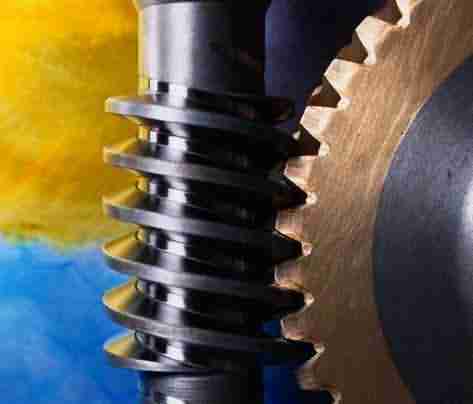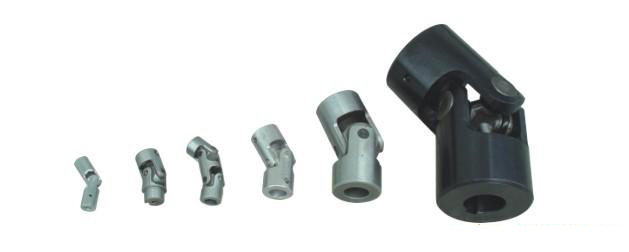GEAR
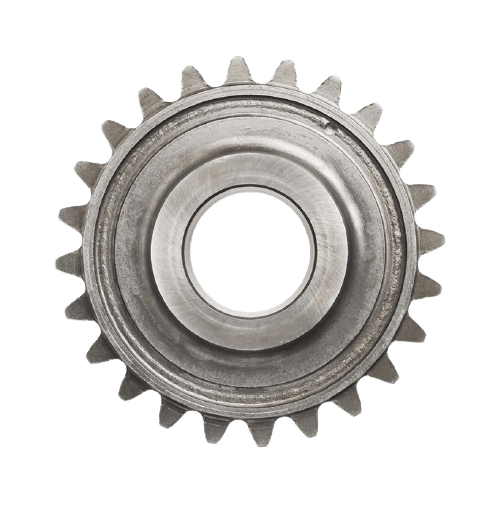
Spur Gears
The most common type of gears employed, spur gears are constructed with straight teeth cut or inserted parallel to the gear’s shaft on a circular (i.e., cylindrical) gear body. In mated pairs, these gears employ the parallel axes configuration to transmit motion and power. Depending on the application, they can be mated with another spur gear, an internal gear (such as in a planetary gear system), or a gear rack (such as in a rack and pinion gear pair).
The simplicity of the spur gear tooth design allows for both a high degree of precision and easier manufacturability. Other characteristics of spur gears include lack of axial load (i.e., the thrust force parallel to the gear shaft), high-speed and high-load handling, and high efficiency rates. Some of the disadvantages of spur gears are the amount of stress experienced by the gear teeth and noise produced during high-speed applications.
This type of gear is used for a wide range of speed ratios in a variety of mechanical applications, such as clocks, pumps, watering systems, power plant machinery, material handling equipment, and clothes washing and drying machines. If necessary for an application, multiple (i.e., more than two) spur gears can be used in a gear train to provide higher gear reduction.
Helical Gears
Similar to spur gears, helical gears typically employ the parallel axes configuration with mated gear pairs, but, if aligned properly, they can also be used to drive non-parallel, non-intersecting shafts. However, unlike spur gears, these gears are constructed with teeth which twist around the cylindrical gear body at an angle to the gear face. Helical gears are produced with right-hand and left-hand angled teeth with each gear pair comprised of a right-hand and left-hand gear of the same helix angle.
The angled design of helical teeth causes them to engage with other gears differently than the straight teeth of spur gears. As properly matched helical gears come in contact with one another, the level of contact between corresponding teeth increases gradually, rather than engaging the entire tooth at once. This gradual engagement allows for less impact loading on the gear teeth and smoother, quieter operation. Helical gears are also capable of greater load capabilities but operate with less efficiency than spur gears. Further disadvantages include the complexity of the helical tooth design, which increases the degree of difficulty in its manufacturing (and, consequently, the cost) and the fact that the single helical gear tooth design produces axial thrust, which necessitates the employment of thrust bearings in any application which uses single helical gears. This latter necessity further increases the total cost of using helical gears.
|
Type of Gear |
Characteristics |
|
Spur |
|
|
Helical |
|
|
Bevel |
|
|
Worm |
|
|
Rack and Pinion |
|
Bevel Gears
Bevel gears are cone-shaped gears with teeth placed along the conical surface. These gears are used to transmit motion and power between intersecting shafts in applications which require changes to the axis of rotation. Typically, bevel gears are employed for shaft configurations placed at 90-degree angles, but configurations with lesser or greater angles are also manageable.
There are several types of bevel gears available differentiated mainly by their tooth design. Some of the more common types of bevel gears include straight, spiral, and hzpt bevel gears.
Straight Bevel Gears
The most commonly used of the bevel gear tooth designs due to its simplicity and, consequently, its ease of manufacturing, straight bevel teeth are designed such that when properly matched straight bevel gears come into contact with one another, their teeth engage together all at once rather than gradually. As is the issue with spur gears, the engagement of straight bevel gear teeth results in high impact, increasing the level of noise produced and amount of stress experienced by the gear teeth, as well as reducing their durability and lifespan.
Spiral Bevel Gears
In spiral bevel gears, the teeth are angled and curved to provide for more gradual tooth engagement and more tooth-to-tooth contact than with a straight bevel gear. This design greatly reduces the vibration and noise produced, especially at high angular velocities (>1,000 rpm). Like helical gears, spiral bevel gears are available with right-hand or left-hand angled teeth. As is also the case with helical gears, these gears are more complex and difficult to manufacture (and, consequently, more expensive), but offer greater tooth strength, smoother operation, and lower levels of noise during operation than straight bevel gears.
Warum sollten Sie uns wählen?
(1) Wir bieten OEM-Dienstleistungen und unterbreiten den Kunden verschiedene Stile und neueste Designs;
(2) Wir arbeiten mit wichtigen Kunden in Südostasien, Afrika, dem Nahen Osten, Nordamerika und Südamerika zusammen;
(3) Nach den Bedürfnissen der Kunden in verschiedenen Regionen, haben wir verschiedene Arten von Reduzierstücke für Sie abgestimmt, so dass unsere Kunden haben große Wettbewerbsfähigkeit auf dem Markt!
(4) Wir haben mehr als 20 Jahre reiche Erfahrung in der Versorgung der Kunden mit hochwertigen Produkten und den professionellsten Dienstleistungen!
(5) Wir können flexibel Waren von jedem Hafen in China exportieren! Sie sind willkommen zu erkundigen!
Unternehmensvorteil:
1. Große Produktionskapazität und schnelle Lieferung.
2. Strenge Qualitätskontrolle Inspektion Regeln: alle Produkte müssen 100% Inspektion vor der Auslieferung passieren.
3. Bereitstellung von OEM/ODM-Dienstleistungen
4. 24-Stunden-Online-Service.
5. Echtzeit-Kursabfrage
6. Hohe Qualität, hohe Zuverlässigkeit und lange Produktlebensdauer.
7. Professionelle Hersteller bieten wettbewerbsfähige Preise.
8. Vielfältige, erfahrene Fachkräfte.
Qualitätsmanagementsystem:
Bei HZPT hat die Qualität von Produkten und Dienstleistungen höchste Priorität.
Unsere Mitarbeiter erhalten Schulungen zu Qualitätsmethoden und -grundsätzen.
Auf jeder Ebene des Unternehmens sind wir bestrebt, die Produktqualität und die Prozesse zu verbessern.
Ein solches Engagement hat uns geholfen, das Vertrauen der Kunden zu gewinnen und die weltweit bevorzugte Marke zu werden.
Paket & Vorlaufzeit
Größe: Zeichnungen
Holzkiste/Container und Palette, oder nach kundenspezifischen Spezifikationen.
15-25 Tage Muster. 30-45 Tage offcial Bestellung
Hafen: Shanghai/Ningbo Hafen
FAQ's
HÄUFIG GESTELLTE FRAGEN:
An den Kunden
Ist der Einkauf in China rentabel?
China ist nach wie vor einer der größten Lieferanten der Welt. Die Produkte, die Sie ausgewählt haben, sind auf Ihren Zielmärkten sicher profitabel, da China die Welt mit wettbewerbsfähiger Qualität und Preisen beliefert.
2) Muss ich nach China reisen, um Produkte zu kaufen?
Wir kümmern uns um alles für Sie, so dass Sie Flugkosten, Hotels und Reisekosten sparen können. Wenn Sie sich jedoch entscheiden, China zu besuchen, werden wir versuchen, Ihnen einen wunderbaren Aufenthalt zu arrangieren, so dass Ihre Reiseerfahrung angenehm sein wird.
3) Welche Art von Produkten liefern Sie?
Eine breite Palette von Produkten für Industrie, Automobil und Landwirtschaft. Jedes Produkt ist einem spezialisierten Team zugeordnet.
4) Welche Risiken bestehen für mich, wenn ich in China einkaufe oder mit Ihnen zusammenarbeite?
Sie haben grundsätzlich keine Risiken. Wir übernehmen den Einkauf für Sie und Sie können sich auf unsere Kontrollen verlassen. Wenn Sie Zeit haben, nach China zu kommen, können Sie uns während des Produktionsprozesses besuchen. Sie haben Zugang zu unseren Kontaktnetzwerken und unserem Verkaufsteam. Wir werden Ihre Produkte genauso ernst nehmen wie unsere. Sie brauchen nicht zu reisen, wenn Sie das nicht wollen, denn Sie haben kompetente Partner in China.
5) Ich kann den Lieferanten für meine Produkte selbst finden, warum brauche ich Sie?
Sie können dies tun. Allerdings werden Ihre Investitionen viel höher sein. Außerdem haben Sie keinen lokalen Partner, der den Markt kennt und Ihnen Zugang zu einem Netzwerk von Möglichkeiten verschaffen kann.
Um Ihre Produkte aus China zu beziehen, benötigen Sie ein Büro vor Ort, um Verträge mit den Lieferanten zu unterzeichnen, und ein Ingenieurteam, das von Zeit zu Zeit Qualitäts- und Mengenkontrollen durchführt. Sie müssen über die Rohstoffquellen Bescheid wissen, und das Wichtigste ist, dass Sie eine Fremdbeschaffung vermeiden.
6) Wie sind Sie strukturiert?
Wir haben verschiedene Abteilungen, die jeweils auf jeden einzelnen Aspekt spezialisiert sind. Wir können logistische Unterstützung, Unterstützung bei der Beschaffung, Unterstützung bei Inspektionen und rechtliche Unterstützung bieten.
7) Ist dieser Dienst nur für große Unternehmen gedacht?
Nein, wir sind sicher, dass Sie beim ersten Mal, wenn Sie mit uns zusammenarbeiten, warmes Vertrauen bekommen werden, um Ihr Geschäft mit uns zu behalten, da unsere Beziehung auf Ehrlichkeit und gegenseitigem Nutzen basiert, so dass Sie in Zukunft Ihr Geschäft vergrößern werden. Wir kümmern uns um Sie und machen Sie viel stärker als zuvor. Wir gehen gemeinsam von Stärke zu Stärke.
Wir heißen jedes Unternehmen willkommen, von klein bis groß...
Für weitere Fragen senden Sie uns bitte eine E-Mail
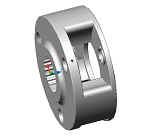

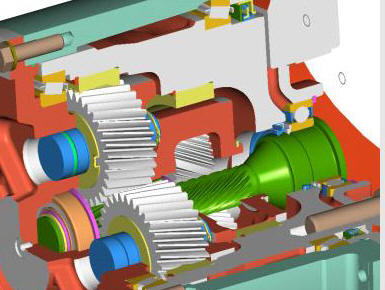

/helica1.jpg)
